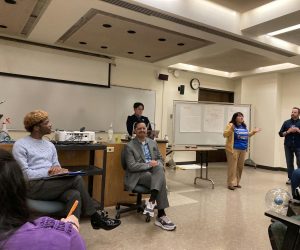What Does It Mean To Be A Hispanic Serving Institution?
September 23, 2014
Recently, a dialogue began on the NEIU campus regarding the question of exactly what it means to be a Hispanic-Serving Institution.
By the U.S Department of Education’s standards, the definition is simple: an institution of higher education that has an enrollment of undergraduate full-time equivalent students that is at least 25 percent Hispanic at the end of the award year immediately preceding the date of application. By this definition, NEIU has been regarded and awarded as an HSI since 2007.
The Developing Hispanic Serving Institution (DHSI) Program is what provides grants to assist HSIs to expand educational opportunities for, and improve the attainment of, Hispanic students. These grants also enable HSIs to expand and enhance their academic offerings, program quality, and institutional stability (U.S Department of Education).
In 2007, the HSI title was awarded to NEIU along with a $2.8 million grant to further the success of the DHSI program. The U.S Department of Education states that it provides these grants to “enable HSI’s to expand and enhance their academic offerings, program quality, and institutional stability.”

Universities awarded with the Title V Grant were required to write abstracts about their plans to use the award money. “Improving Retention Through Academic Literacy” through the academic years of 2007-2012 was the goal of NEIU’s plan.
The activities that were to be generated are as follows on the original abstract: “a revised first year writing program with a common syllabi, full-time coordination and online course offerings; a Center for Academic Literacy to provide tutoring services and writing support for NEIU students; a faculty development program to incorporate writing-intensive components across disciplines; and student writing evaluation resources to accurately assess student writing performance.”
NEIU has also made other efforts through the creation of programs such as Proyecto Pa’Lante, El Centro, and Latino and Latin American Studies that serve the growing Latino community. NEIU is looking to recruit, admit, and support Latino and 1st generation Latino students, and help guide them to graduation.
Assistant Professor of Social Work and Director of ENLACE Leadership Institute at NEIU, Francisco X Gaytan, stated in a recent discussion that in 2011, 69% of Latino high school students graduated in the U.S., and of this 69%, 72% went on to some post-secondary degree program adding up to about 20% of all 18-24 year olds that live in the U.S and go onto college being of Latino heritage (roughly 6 million students). Of these nearly 6 million students, Gaytan reported that over half (57.1%) of these Latino students choose HSI’s. However, out of the 6 million students that go onto college, only 8.5% (or 510,000) graduate.
NEIU has been the only HSI in the Midwest for the past 7 years, though it only ranks 6th in terms of Latino students that graduate in 150% of ‘Normal time’ to completion for their program (National Center for Educational Statistics). Placing NEIU behind schools like University of Illinois at Urbana-Champaign, DePaul University, University of Illinois at Chicago, and Northern Illinois University which primarily have less than 25% full-time Latino student body.
As Gaytan stated, U of I currently has a 7% Latino student body, but graduates 84% of these students in contrast to Northeastern who’s Latino Freshman Class in 2013 was at 51%, but graduating class was 24.7%.
Some contributors advise that the school hire more tenured Latino faculty, as there is a correlation with a larger number of Latino students in relation to more Latino professors.
Others suggest that student employment on campus be open to all students, even those who are non-documented as students who work on campus are more likely to stay enrolled and graduate.







